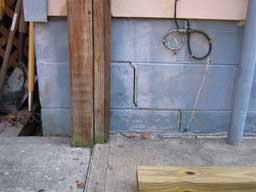Expansive soils, frost heave, and compressive soils cause more significant damage to man-made structures in the U.S. than any other natural hazard. This type of damage is not as sudden or traumatic as that caused by earthquakes, tornadoes, or hurricanes, but losses have been estimated at seven billion dollars annually. The United States Department of Agriculture estimates that one half of the homes in the United States are built on expansive soils, and the American Society of Civil Engineers estimates that a quarter of all homes have suffered damage caused by these soils.
Soils that exhibit changes in volume with changing moisture content are called expansive soils. The capacity of a soil to shrink and swell is related to the clay minerals present, particularly montmorillonite, which can swell up to fifteen times its dry volume and generate pressures in excess of 30,000 pounds per square foot. A key factor is the depth of seasonal change of soil moisture, and conditions such as rerouted drainage, leaking pipes, downspouts, or the presence of large trees can locally affect moisture and may increase the shrink/swell behavior of expansive soils. Expansive soils may be recognized by the large cracks that form during droughts, and laboratory tests can confirm soil properties. Expansive soil hazards are exacerbated by prolonged drought followed by soil-saturating precipitation events.

Foundation crack due to differential soil settlement
Frost heave is the upheaval of ground due to soil freezing and growth of ice crystals. Frost heave typically occurs in silty soils with shallow groundwater, where capillary action can supply water to the zone of ice build-up. Frost heave is enhanced during extended cold spells.
Soils that are highly compressive also represent potential hazards to structures. Most highly compressive soils are fine-grained, loosely packed, and usually contain appreciable amounts of organic material. Suburban developments frequently contain buried construction waste or decaying root systems.
Although problem soils do not affect human health, they are a widespread cause of property damage, ranging from jammed doors and windows to warped flooring, ruptured foundations, cracked swimming pools, buckled roads, and severed utility lines. Heavy loads such as chimneys resist uplift, while lighter loads such as concrete patios cannot, leading to differential settling of structures. Wetting and drying cycles and the resulting expansions and contractions cause repetitive stress. Standard homeowner’s insurance does not cover damage from expansive/compressive soils or frost heave.
The full magnitude of these hazards in Virginia is unknown, although parts of Chesterfield County have experienced significant impacts to residential areas developed over expansive soils. The Coastal Plain, the Shenandoah Valley, and the Mesozoic basins around Culpeper, Farmville, Danville, and Richmond are the most likely areas to have expansive or frost-heave-susceptible soils; however, the exact distribution can only be approximated from current soil maps, and field visits to specific areas are necessary to determine the actual extent of these hazards.
Selected References:
Dawson, R. F. 1953, The design of building footing on expansive clay soils in housing and building in hot-humid and hot-dry climates: Building Research Advisory Board. Research Conference Report No. 5. p. 83-90.
Freeman, T. J., Littlejohn, G. S., and Driscoll, R.M.C., 1994, Has your house got cracks?: A guide to subsidence and heave of buildings on clay: Institution of Civil Engineers and the Building Research Establishment, Thomas Telford Services, Ltd., London, 114 p.
Greenfield, S. J. and Shen, C. K., 1992, Foundations on problem soils: A guide to lightly loaded foundation construction for challenging soil and site conditions: Prentice-Hall, Inc., Englewood Cliffs, New Jersey, 240 p.
Jones, D. E., and Holtz, W. G., 1973, Expansive soils — the hidden disaster: Civil Engineering: American Society of Civil Engineers, v. 43, n.8, p. 49-51.
Krohn, J.P., and Slosson, J. E., 1980, Assessment of expansive soils in the United States, in Snethen, Donald, ed., Expansive soils: American Society of Civil Engineers, Proceedings of the Fourth International Conference on Expansive Soils, v. 1, p. 599-608.
Nelson, J. D. and Miller, D. J., 1992, Expansive soils: Problems and Practice in Foundations and Pavement Engineering: John Wiley & Sons, Inc., New York, 259 p.
Olive, W.; Chleborad, A.; Frahme, C.; Shlocker, J.; Schneider, R; and Schuster, R., 1989 Swelling Clays Map of the Conterminous United States USGS Miscellaneous Investigations Series Map I-1940
Snethen, Donald, ed., 1980, Fourth International Conference on Expansive Soils: American Society of Civil Engineers, New York, v. 1 & 2, 917 p.
Wray, W. K., 1995, So your home is built on expansive soils: A discussion of how expansive soils affect buildings: ASCE Publications, 65 p.
